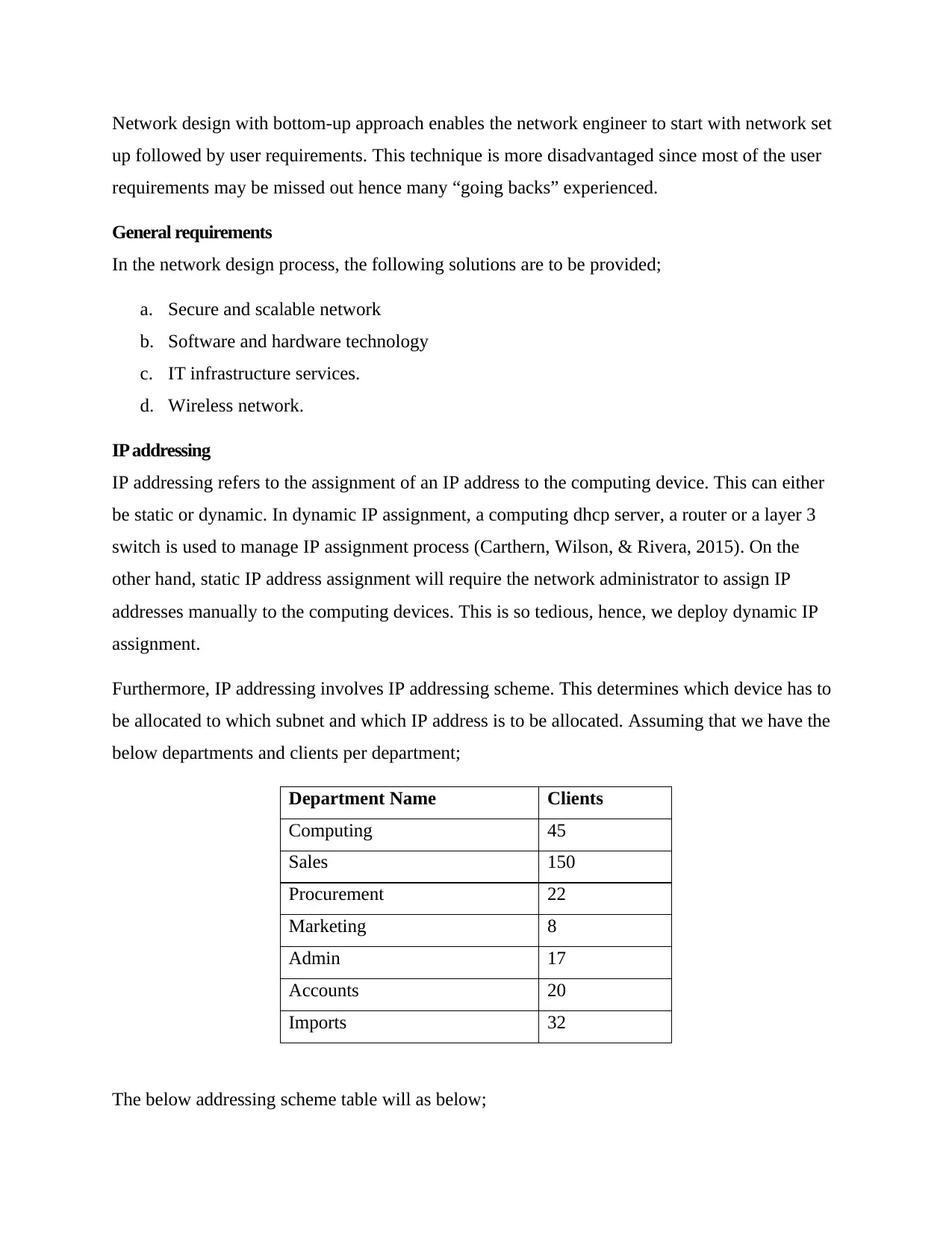Network Design and Implementation Report - Electrical Engineering
VerifiedAdded on 2022/11/30
|7
|1120
|500
Report
AI Summary
This report delves into the realm of network design and implementation, emphasizing the utilization of a structured methodology to ensure project success. It begins by highlighting the significance of network design in modern business enterprises and introduces two key design techniques: the top-down and bottom-up approaches. The report advocates for the top-down approach, illustrating its alignment with the OSI model and its advantages in adapting to network application requirements. It outlines the stages of the top-down approach, including business requirements analysis, technology selection, and network design, while also addressing the importance of IP addressing schemes and the implementation of routing protocols like OSPF. The report provides a practical IP addressing scheme example for different departments and concludes by emphasizing the importance of planning in network design and the adoption of the top-down strategy.

Course Title:
Student Name and Code:
Lecture Name:
Student School Affiliation:
Student Name and Code:
Lecture Name:
Student School Affiliation:
Paraphrase This Document
Need a fresh take? Get an instant paraphrase of this document with our AI Paraphraser

Network Design
Abstract
Each system to be implemented or a task to be performed requires a methodology or a
framework to follow as a guideline to ensure the success of the implementation. A guideline
whose framework is structured makes it easy to plan and manage projects. This reduces
difficulties such as low quality, failure to meet requirements, running out of the estimated time,
high implementation cost, expensive maintenance and inefficient work. In the art of networking,
the whole concept of network designing is simplified via the use of structured or planned
techniques. In structured design technique, a set of distinct steps that assist to guarantee that all
the necessary tasks in the network design practice are achieved.
In this article paper, we will concentrate on network design and implementation techniques and
select the most appropriate method for our network design.
Introduction
Information and computer networks are essential to the success of any business enterprise, both
small and large. IT infrastructure supports applications, connects people and provides access to
the resources which keep the business enterprises running. In order to realize the daily needs of
business enterprises, network designs are becoming complex. To manage the complexity of our
network requirements we will at two methods of network design, that is, top-down and bottom-
up approach techniques.
Top – down
Mason defines top-down approach as the design that refers to the starting of the network design
process from the topmost layer of OSI and moving down. The top down technique is best suited
as it permits a network and relevant infrastructure to be modified as per the requirements of the
network application (Mason, 2019). In this network design approach, the devices and
technologies are only chosen after the detailed analysis of the network needs have be done.
The top down approach is juxtaposed to OSI layers as below:
Abstract
Each system to be implemented or a task to be performed requires a methodology or a
framework to follow as a guideline to ensure the success of the implementation. A guideline
whose framework is structured makes it easy to plan and manage projects. This reduces
difficulties such as low quality, failure to meet requirements, running out of the estimated time,
high implementation cost, expensive maintenance and inefficient work. In the art of networking,
the whole concept of network designing is simplified via the use of structured or planned
techniques. In structured design technique, a set of distinct steps that assist to guarantee that all
the necessary tasks in the network design practice are achieved.
In this article paper, we will concentrate on network design and implementation techniques and
select the most appropriate method for our network design.
Introduction
Information and computer networks are essential to the success of any business enterprise, both
small and large. IT infrastructure supports applications, connects people and provides access to
the resources which keep the business enterprises running. In order to realize the daily needs of
business enterprises, network designs are becoming complex. To manage the complexity of our
network requirements we will at two methods of network design, that is, top-down and bottom-
up approach techniques.
Top – down
Mason defines top-down approach as the design that refers to the starting of the network design
process from the topmost layer of OSI and moving down. The top down technique is best suited
as it permits a network and relevant infrastructure to be modified as per the requirements of the
network application (Mason, 2019). In this network design approach, the devices and
technologies are only chosen after the detailed analysis of the network needs have be done.
The top down approach is juxtaposed to OSI layers as below:

Figure 1: OSI Layer – Top-Down Approach Comparison
As depicted in the diagram above, the top down approach begins with the analyses of the
business requirements. Technology required to implement the network system comes next and
finally the design stage follows.
The analyses stage takes care of the network services required and applications necessary to
drive the business activity. Such services and applications include printing, DNS, DHCP, mailing
and messaging, file storage and sharing and content management (Empson, 2013).
For the technologies required to implement a network system include; routing, switching,
infrastructure management, services management and network security techniques.
The top down network design approach has an advantage of giving an opportunity to network
users to express their requirements before network design takes place. By doing this, all user
requirements are discussed and filtration done on what should be implemented and what is to be
dropped. This minimizes the chances of “going-back” during project implementation.
However, this technique of network design has a disadvantage of consuming more time due to
consultations and argument settlement.
Bottom up approach
As depicted in the diagram above, the top down approach begins with the analyses of the
business requirements. Technology required to implement the network system comes next and
finally the design stage follows.
The analyses stage takes care of the network services required and applications necessary to
drive the business activity. Such services and applications include printing, DNS, DHCP, mailing
and messaging, file storage and sharing and content management (Empson, 2013).
For the technologies required to implement a network system include; routing, switching,
infrastructure management, services management and network security techniques.
The top down network design approach has an advantage of giving an opportunity to network
users to express their requirements before network design takes place. By doing this, all user
requirements are discussed and filtration done on what should be implemented and what is to be
dropped. This minimizes the chances of “going-back” during project implementation.
However, this technique of network design has a disadvantage of consuming more time due to
consultations and argument settlement.
Bottom up approach
⊘ This is a preview!⊘
Do you want full access?
Subscribe today to unlock all pages.

Trusted by 1+ million students worldwide

Network design with bottom-up approach enables the network engineer to start with network set
up followed by user requirements. This technique is more disadvantaged since most of the user
requirements may be missed out hence many “going backs” experienced.
General requirements
In the network design process, the following solutions are to be provided;
a. Secure and scalable network
b. Software and hardware technology
c. IT infrastructure services.
d. Wireless network.
IP addressing
IP addressing refers to the assignment of an IP address to the computing device. This can either
be static or dynamic. In dynamic IP assignment, a computing dhcp server, a router or a layer 3
switch is used to manage IP assignment process (Carthern, Wilson, & Rivera, 2015). On the
other hand, static IP address assignment will require the network administrator to assign IP
addresses manually to the computing devices. This is so tedious, hence, we deploy dynamic IP
assignment.
Furthermore, IP addressing involves IP addressing scheme. This determines which device has to
be allocated to which subnet and which IP address is to be allocated. Assuming that we have the
below departments and clients per department;
Department Name Clients
Computing 45
Sales 150
Procurement 22
Marketing 8
Admin 17
Accounts 20
Imports 32
The below addressing scheme table will as below;
up followed by user requirements. This technique is more disadvantaged since most of the user
requirements may be missed out hence many “going backs” experienced.
General requirements
In the network design process, the following solutions are to be provided;
a. Secure and scalable network
b. Software and hardware technology
c. IT infrastructure services.
d. Wireless network.
IP addressing
IP addressing refers to the assignment of an IP address to the computing device. This can either
be static or dynamic. In dynamic IP assignment, a computing dhcp server, a router or a layer 3
switch is used to manage IP assignment process (Carthern, Wilson, & Rivera, 2015). On the
other hand, static IP address assignment will require the network administrator to assign IP
addresses manually to the computing devices. This is so tedious, hence, we deploy dynamic IP
assignment.
Furthermore, IP addressing involves IP addressing scheme. This determines which device has to
be allocated to which subnet and which IP address is to be allocated. Assuming that we have the
below departments and clients per department;
Department Name Clients
Computing 45
Sales 150
Procurement 22
Marketing 8
Admin 17
Accounts 20
Imports 32
The below addressing scheme table will as below;
Paraphrase This Document
Need a fresh take? Get an instant paraphrase of this document with our AI Paraphraser

Subnet
Name
Neede
d Size
Address Mask Dec Mask Assignable
Range
Broadcast
Sales 150 192.168.16.
0
/24 255.255.255.0 192.168.16.1
-
192.168.16.2
54
192.168.16.2
55
Computing 45 192.168.17.
0
/26 255.255.255.1
92
192.168.17.1
-
192.168.17.6
2
192.168.17.6
3
Imports 32 192.168.17.
64
/26 255.255.255.1
92
192.168.17.6
5 -
192.168.17.1
26
192.168.17.1
27
Procureme
nt
22 192.168.17.
128
/27 255.255.255.2
24
192.168.17.1
29 -
192.168.17.1
58
192.168.17.1
59
Accounts 20 192.168.17.
160
/27 255.255.255.2
24
192.168.17.1
61 -
192.168.17.1
90
192.168.17.1
91
Admin 17 192.168.17.
192
/27 255.255.255.2
24
192.168.17.1
93 -
192.168.17.2
22
192.168.17.2
23
Marketing 8 192.168.17.
224
/28 255.255.255.2
40
192.168.17.2
25 -
192.168.17.2
38
192.168.17.2
39
(Andrews, 2016)
Name
Neede
d Size
Address Mask Dec Mask Assignable
Range
Broadcast
Sales 150 192.168.16.
0
/24 255.255.255.0 192.168.16.1
-
192.168.16.2
54
192.168.16.2
55
Computing 45 192.168.17.
0
/26 255.255.255.1
92
192.168.17.1
-
192.168.17.6
2
192.168.17.6
3
Imports 32 192.168.17.
64
/26 255.255.255.1
92
192.168.17.6
5 -
192.168.17.1
26
192.168.17.1
27
Procureme
nt
22 192.168.17.
128
/27 255.255.255.2
24
192.168.17.1
29 -
192.168.17.1
58
192.168.17.1
59
Accounts 20 192.168.17.
160
/27 255.255.255.2
24
192.168.17.1
61 -
192.168.17.1
90
192.168.17.1
91
Admin 17 192.168.17.
192
/27 255.255.255.2
24
192.168.17.1
93 -
192.168.17.2
22
192.168.17.2
23
Marketing 8 192.168.17.
224
/28 255.255.255.2
40
192.168.17.2
25 -
192.168.17.2
38
192.168.17.2
39
(Andrews, 2016)

Routing
Routing refers transfer of data from one network to another (Lammle, 2016). In our network
design we will be using OSPF routing protocol.
Conclusion.
Conclusively, network design requires good planning which will ensure the smooth flow of the
project. However, this is very rare. In our network design, will deploy top down network design
strategy.
Routing refers transfer of data from one network to another (Lammle, 2016). In our network
design we will be using OSPF routing protocol.
Conclusion.
Conclusively, network design requires good planning which will ensure the smooth flow of the
project. However, this is very rare. In our network design, will deploy top down network design
strategy.
⊘ This is a preview!⊘
Do you want full access?
Subscribe today to unlock all pages.

Trusted by 1+ million students worldwide

References
Andrews, J. (2016). A+ Guide to Hardware. Boston: Cengage Learning.
Carthern, C., Wilson, ., & Rivera, . (2015). Cisco Networks: Engineers' Handbook of Routing, Switching,
and Security. New York City: Apress.
Empson, S. (2013). CCNA Routing and Switching Portable Command Guide (ICND1 100-105, ICND2 200-
105, and CCNA 200-125). Indianapolis: Cisco Press.
Lammle, T. (2016). CCNA Routing and Switching Complete Study Guide Exam 100-105, Exam 200-105,
Exam 200-125 . Hoboken: John Wiley & Sons.
Mason, D. (2019). Computer Networking; A Top-Down Approach. Los Angeles: Rico Publications.
Andrews, J. (2016). A+ Guide to Hardware. Boston: Cengage Learning.
Carthern, C., Wilson, ., & Rivera, . (2015). Cisco Networks: Engineers' Handbook of Routing, Switching,
and Security. New York City: Apress.
Empson, S. (2013). CCNA Routing and Switching Portable Command Guide (ICND1 100-105, ICND2 200-
105, and CCNA 200-125). Indianapolis: Cisco Press.
Lammle, T. (2016). CCNA Routing and Switching Complete Study Guide Exam 100-105, Exam 200-105,
Exam 200-125 . Hoboken: John Wiley & Sons.
Mason, D. (2019). Computer Networking; A Top-Down Approach. Los Angeles: Rico Publications.
1 out of 7
Related Documents
Your All-in-One AI-Powered Toolkit for Academic Success.
+13062052269
info@desklib.com
Available 24*7 on WhatsApp / Email
![[object Object]](/_next/static/media/star-bottom.7253800d.svg)
Unlock your academic potential
Copyright © 2020–2025 A2Z Services. All Rights Reserved. Developed and managed by ZUCOL.


